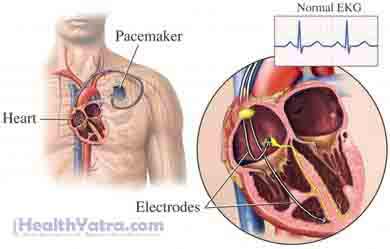Definition
This is a procedure to insert an artificial pacemaker. A pacemaker is a small, battery-operated device. It helps maintain a normal heartbeat by sending electrical impulses to the heart.

Reasons for Procedure
A pacemaker can be inserted when:
- The body’s natural pacemaker, the sinoatrial (SA) node, is not working properly. When the SA node is not working correctly, the heart can beat too slowly.
- There are malfunctions in the atrioventricular (AV) node, the part of the heart’s electrical system that sends signals from the SA node to the ventricles. This leads to a very slow heartbeat.
- Heart performance in people with severe symptoms of congestive heart failure and a weakened heart muscle ( cardiomyopathy) needs to be improved. This is called biventricular pacing, or cardiac resynchronization therapy.
- Cardiac surgery is being done.
Possible Complications
Complications are rare, but no procedure is completely free of risk. If you are planning to have a pacemaker inserted, your doctor will review a list of possible complications, which may include:
- Excess bleeding
- Infection
- Pacemaker malfunction
- Rupture in the heart muscle (rare)
- Inappropriate stimulation of the diaphragm (large muscle between chest and abdominal cavities)
Factors that may increase the risk of complications include:
- Obesity
- History of smoking
- History of excess alcohol consumption
- Bleeding or blood-clotting irregularities
- Regular use of some medicines
Be sure to discuss these risks with your doctor before the procedure.
What to Expect
Prior to Procedure
Before the procedure, your doctor will likely do:
- Blood tests
- Chest x-rays —a test that uses radiation to take pictures of structures inside the chest
- Electrocardiogram (ECG, EKG)—a test that records the heart’s activity by measuring electrical currents through the heart muscle
In the days leading up to the procedure:
- Talk to your doctor about your medicines. You may be asked to stop taking some medicines up to one week before the procedure, like:
- Anti-inflammatory drugs (eg, aspirin )
- Blood thinners, such as clopidogrel (Plavix) or warfarin (Coumadin)
- Eat a light meal the night before the procedure. Do not eat or drink anything after midnight.
Anesthesia
Local anesthesia will be used. This means that only the area being operated on is numbed. It is given as an injection.
Description of the Procedure
You will lie flat on a hard table. Your heart rate, blood pressure, and breathing will be monitored. The doctor will make a small incision beneath your collarbone. The pacemaker will be inserted through this incision. The wires will be threaded through a vein under the collarbone to your heart. Lastly, the incision will be closed with stitches.
Immediately After Procedure
Your heart rate and blood pressure will be monitored.
How Long Will It Take?
About 2 hours
How Much Will It Hurt?
You will have pain after the procedure. Your doctor will treat your pain with medicine.
Post-procedure Care
Before you leave the care center, the pacemaker will be programmed to fit your pacing needs. When you return home, do the following to help ensure a smooth recovery:
- Ask your doctor about when it is safe to shower, bathe, or soak in water.
- Return to normal activities as soon as you feel able. It may take about two weeks for you to recover.
- Avoid strenuous activity, especially involving the upper body, for 4-6 weeks.
- Avoid excessive movement of the arm/shoulder on the side of the pacemaker for two weeks. This will help you to avoid dislodging the leads. You may be given a sling to wear to help remind you.
- Resume driving in about one week.
- Have the stitches removed in about one week.
- Now that you have a pacemaker, you may need to avoid:
- MRI scans
- Heat therapy (often used in physical therapy)
- High-voltage or radar machinery (eg, electric arc welders, high-tension wires, radar installations, or smelting furnaces)
- Contact with radio or television transmitters
- Do not carry a cell phone in a pocket directly over the device. Keep the phone on the side away from the device. Also, headphones worn with MP3 players may cause interference.
- Turn off car or boat motors when working on them. (They may “confuse�? your device.)
- Tell your doctors and dentist that you have a pacemaker.
- Check with your doctor about the safety of going through airport security detectors with your device.
- Be sure to follow your doctor’s instructions .
A hard ridge may form on the skin along the incision. This usually recedes as the wound heals.
Call Your Doctor
After arriving home, contact your doctor if any of the following occurs:
- Signs of infection, including fever and chills
- Redness, swelling, increasing pain, excessive bleeding, or any discharge from the incision site
- Pain that you cannot control with the medicines you have been given
- Cough, shortness of breath, or chest pain
- Heartbeat irregularities
- New symptoms
In case of an emergency, call for medical help right away.
